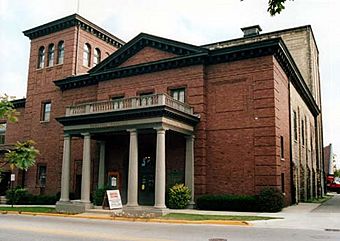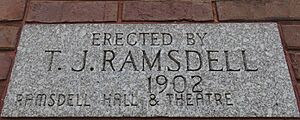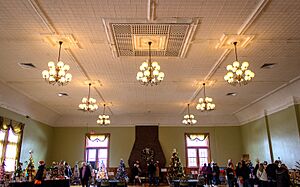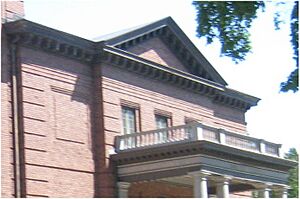Ramsdell Theatre facts for kids
Quick facts for kids |
|
|
Ramsdell Theatre
|
|
 |
|
| Location | 101 Maple St, Manistee, Michigan |
|---|---|
| Area | 1 acre (0.40 ha) |
| Built | 1902—1903 |
| Architect | Solon Spencer Beman |
| Architectural style | possible Colonial Revival architecture or Greek Revival architecture |
| NRHP reference No. | 72000640 |
| Added to NRHP | January 13, 1972 |
The Ramsdell Theatre is a historic building in Manistee, Michigan. It was built as a playhouse and opera house. A local businessman and politician named Thomas Jefferson Ramsdell paid for it. Construction started in 1902. The theatre replaced two older opera houses in town that had burned down. Besides plays, the Ramsdell Theatre was also used to show movies. Famous actor James Earl Jones began his acting career here.
Contents
About the Building
The Ramsdell Theatre is known as one of the best opera houses built in small Michigan cities around the early 1900s. It was built between 1902 and 1903. Thomas Jefferson Ramsdell, who was the only lawyer in town, paid $100,000 for it. This was a very large sum of money at the time! The building was designed by architect Solon Spencer Beman.
The theatre is located at First and Maple Streets. It was named a National Historic Landmark in 1972. The state of Michigan also recognized it as a Michigan Historic Site in 1980. Today, the Theatre and the Ramsdell Great Hall next to it work as a community center.
Building Design
The Ramsdell Theatre's design is often described as Greek Revival or classic Colonial. The front of the building is made of red brick. It has Doric columns that hold up a flat porch over the main entrance.
The Theatre and the Ramsdell Great Hall are separate buildings. They were built around the same time but have a solid wall between them. The theatre has a sloped roof with decorative blocks that look like teeth. It also has a fancy porch, a grand entrance, and special brick designs. Inside, there is a beautiful dome painting.
Inside the Theatre
The theatre has two balconies and special private viewing boxes on the main floor. The number of seats has been reduced to 489 from its original 1200. This is partly because the upper balcony is now closed for fire safety. There are two seating boxes near each side of the stage. Two more are in the lower balcony.
An interesting part of the inside is that the balconies are shaped like a horseshoe. The main auditorium has been changed more than the outside. A major change was adding a projection booth in the middle of the top balcony. This booth was built before April 1925. It allowed movies to be shown.
The Stage
The stage is about 34 feet (10 meters) deep and 60 feet (18 meters) wide. The opening of the stage, called the proscenium arch, is 26 feet (8 meters) wide. The frame above the stage, where lights hang, is 70 feet (21 meters) high. Two areas for stagehands, called fly galleries, are almost 30 feet (9 meters) above the stage.
There is also a special paint gallery 33 feet 10 inches (10.3 meters) above the stage floor. This allowed artists to paint scenery backdrops while they were hanging up. The theatre also has nine trapdoors on the stage. Three can go down, and six can come up from the stage.
Art and Decorations
The front curtain, called A Grove Near Athens, was painted by Walter Burridge. It is still used today. Burridge was a famous artist who painted scenery for plays and operas across the United States. He also created large circular paintings for national exhibitions.
Frederick Winthrop Ramsdell, who was Thomas Jefferson Ramsdell's son, painted the dome in the auditorium. He also painted two curved areas in the lobby. The lobby paintings show women listening to a young musician. The dome painting shows Venus, a Roman goddess, riding a chariot through the sky with small angels around her.
Planning and Building the Theatre
Planning for the Ramsdell Theatre began in 1901. This was after two earlier opera houses in Manistee had been destroyed by fire. The theatre built by Ramsdell is the one still standing and used today.
The Assembly Hall next to the theatre was finished in 1901. An opening party was held there in December 1902. The theatre itself officially opened on September 4, 1903. The first show was a play called A Chinese Honeymoon. Tickets for this first show were very expensive, from $10 to $25. Later shows had lower ticket prices.
When it was being built, some people called the theatre "Ramsdell's Folly." This was partly because it cost so much money. The original plan was to spend $25,000. But it ended up costing $100,000 when it was finished.
History of the Theatre
From 1903 to 1914, the Ramsdell Theatre was used for many different events. These included plays by professional touring groups, local amateur plays, and movie screenings. By 1914, the theatre was not used as much for live performances. By the 1920s, the theatre space was mostly empty. It remained unused for stage productions until 1951.
Thomas Jefferson Ramsdell passed away in 1917. In 1925, the Manistee Rotary Club bought the theatre from his estate for $25,000. The Rotary Club mainly used the theatre as a movie cinema. They also had occasional vaudeville shows, which were variety acts. The Butterfield Theatre chain leased it in 1927 to show movies. Butterfield held the lease until the City of Manistee took control in 1941.
The Manistee Civic Players group formed in 1939. The Butterfield company allowed them to use the theatre for two plays and their rehearsals each year. The Civic Players performed many shows over the next few years. In 1943, the City of Manistee bought the Theatre from the Rotary Club. The City only used the Assembly Hall for a recreation group, leaving the Theatre itself closed. In 1950, a group of women's clubs formed the Civic Betterment Committee. Their goal was to bring the Ramsdell Theatre back to life.
The Manistee Drama Festival started in 1951. Their first season included plays like George Washington Slept Here and Dracula. The money earned from these shows helped to restore parts of the theatre. In 1952, the festival changed its name to the Manistee Summer Theatre. Madge Skelly was hired as an assistant director. Skelly directed eight plays that year. She became the managing director in 1953, the same year the city bought the theatre and hall. Skelly was in charge of the Summer Theatre until 1961. After 1963, the Manistee Civic Players began producing three or four shows each year. One of these is usually a musical.
Actor James Earl Jones worked at the Ramsdell during the summer of 1953. He was a stage carpenter and sometimes acted. From 1955 to 1957, he was the Summer Theatre's stage manager. He also took on more challenging acting roles. Jones first played Shakespeare's character Othello at the Ramsdell in 1956. He performed this role while also working as stage carpenter and stage manager. He has returned twice to help raise money for the theatre's restoration.
In 1990, the Ramsdell Restoration Committee was formed to raise money and manage repairs. The Ramsdell Governance Committee was created in 2005 by local business people. The city took over responsibility for the building in 2006.
Historical Marker
There is a Michigan State Historical Marker at the front entrance of the theatre.








